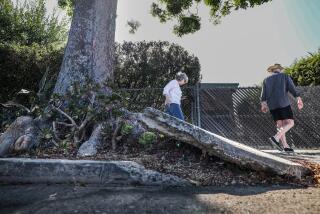City, county join forces in program to help homeless get off skid row
- Share via
Los Angeles city and county workers launched a major effort Wednesday to clean up skid row and offer medical, mental health and social services to help an estimated 1,700 homeless people get off the streets.
Dr. Susan Partovi, the medical field director for the Los Angeles County Department of Health Services, joined 35 city sanitation and street service workers, and a couple dozen mental health, medical and outreach workers, on San Julian Street between 5th and 6th streets.
------------
FOR THE RECORD:
Skid row cleanup: An article in the Aug. 14 LATExtra section about a cleanup and outreach operation on skid row quoted a homeless woman, Michele Jones, as saying St. Vincent Medical Center in Los Angeles had discharged her in the middle of the night after back surgery. Elizabeth Nikels, a spokeswoman for St. Vincent, said the hospital has no record of having had Jones as a patient.
------------
“The goal is to house up to 10,000 people” in the next five years, Partovi said during a briefing before the cleanup. “Some of these people are acutely ill.”
Authorities described the $3.7-milion city-county program, called Operation Healthy Streets, as an unprecedented show of cooperation in an attempt to shake loose entrenched homelessness in the most concentrated skid row in the nation.
“We have coordination with the county, something we have rarely done in our approach to homelessness,” Los Angeles City Councilman Jose Huizar said. Huizar has also called for the appointment of an official to oversee the city’s initiatives on the homeless.
As several rats scuttled in and out of holes, sanitation workers in white protective suits threw away hazardous waste, then bagged homeless people’s belongings, mostly bedding and clothing, to store for 90 days for pickup by their owners.
Officials say that the cleanup will continue through Aug. 21, and be repeated bimonthly, on a 30-block grid from Wall to Gladys streets, between 5th and 7th streets. Spot touch-ups are also planned.
Many homeless residents are skeptical of the new approach after decades of failed cleanup efforts.
“People want to get off the streets, they don’t want to go where they send them,” said a homeless man who gave his name as Philip. He complained that some shelters require attendance at religious services or demand a sizable portion of people’s meager general relief check for rent.
Los Angeles native Omar Allah, 29, said there is no room in the shelters. “You’ve got to go to jail to find out about housing,” said Allah, who sat on a milk crate around the corner from San Julian, where he had been staying before the cleanup started.
“That’s your real house, jail,” said his friend, Mike Johnson, 30.
Partovi said the resistance to shelters and temporary housing is understandable. “They all want their own place,” she said, adding that the county is developing permanent housing that includes care for mental health, substance abuse and medical issues.
Teams will also have to contend with early jail and patient releases that feed skid row’s population.
Michele Jones, 30, said St. Vincent Medical Center in Los Angeles discharged her in the middle of the night after back surgery, leaving her nowhere to go but skid row.
“I’ve tried to get into a place, nobody will help me,” said the Northridge native, who still had an EKG electrode patch stuck to her chest.
St. Vincent spokeswoman Ann Betzsold said she could not comment on Jones’ statements.
Partovi said the county is opening two centers this year where patients can recuperate after hospitalization.
During the cleanup, General Dogon, an organizer with the Los Angeles Community Action Network anti-poverty group, confronted Huizar, saying that Operation Healthy Streets funds would be better spent paying neighborhood residents who have been cleaning the streets on their own during years of official neglect.
Dogon also said the city was not doing enough. “People need resources on a daily basis,” he said.
But other new plans are afoot. The city and county, pushed by federal officials, are moving toward a “housing first” strategy that places people in apartments even if they have substance abuse or mental health issues.
Since 2008, Los Angeles County has committed to spending $118 million on 41 housing developments with a total of 2,066 residences, including 918 set aside for people who are mentally ill and homeless.
Partovi said her department has also set up an $18-million fund to subsidize rent for homeless people who cycle in and out of hospital care and emergency rooms.
Twitter: @geholland
Times staff writer Irfan Khan contributed to this report.
More to Read
Sign up for Essential California
The most important California stories and recommendations in your inbox every morning.
You may occasionally receive promotional content from the Los Angeles Times.














